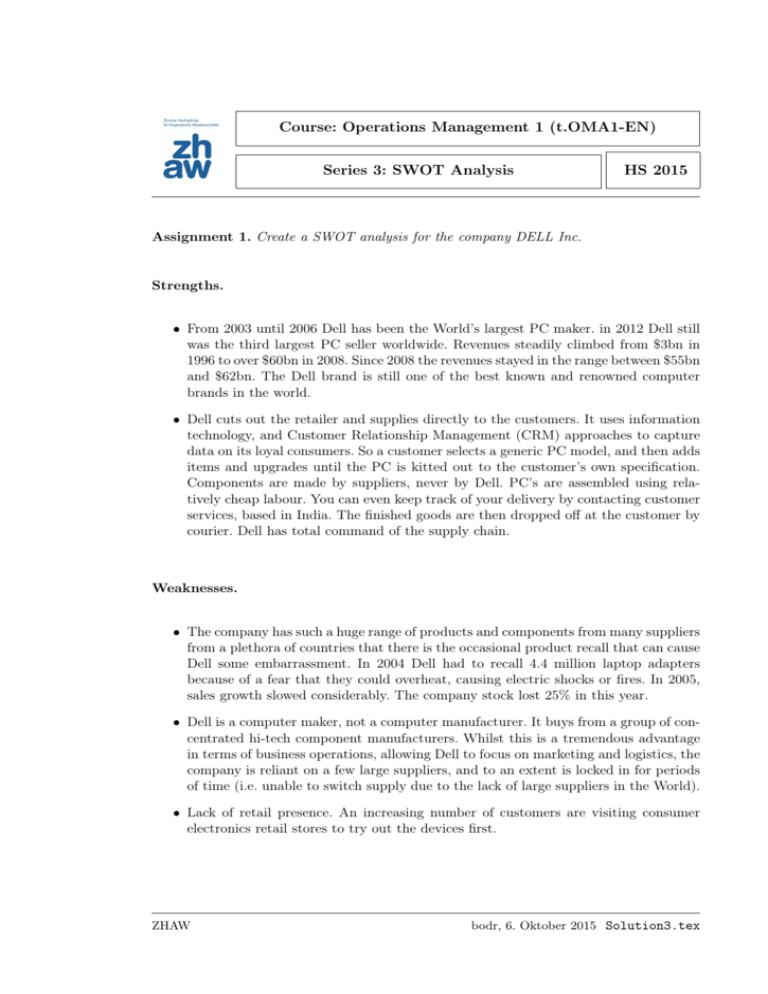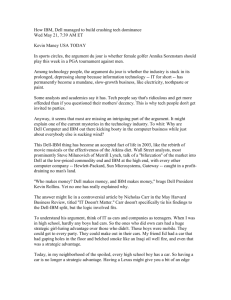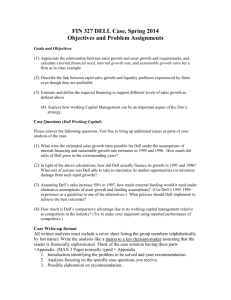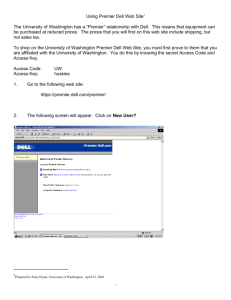Course: Operations Management 1 (t.OMA1
advertisement

Course: Operations Management 1 (t.OMA1-EN) Series 3: SWOT Analysis HS 2015 Assignment 1. Create a SWOT analysis for the company DELL Inc. Strengths. • From 2003 until 2006 Dell has been the World’s largest PC maker. in 2012 Dell still was the third largest PC seller worldwide. Revenues steadily climbed from $3bn in 1996 to over $60bn in 2008. Since 2008 the revenues stayed in the range between $55bn and $62bn. The Dell brand is still one of the best known and renowned computer brands in the world. • Dell cuts out the retailer and supplies directly to the customers. It uses information technology, and Customer Relationship Management (CRM) approaches to capture data on its loyal consumers. So a customer selects a generic PC model, and then adds items and upgrades until the PC is kitted out to the customer’s own specification. Components are made by suppliers, never by Dell. PC’s are assembled using relatively cheap labour. You can even keep track of your delivery by contacting customer services, based in India. The finished goods are then dropped off at the customer by courier. Dell has total command of the supply chain. Weaknesses. • The company has such a huge range of products and components from many suppliers from a plethora of countries that there is the occasional product recall that can cause Dell some embarrassment. In 2004 Dell had to recall 4.4 million laptop adapters because of a fear that they could overheat, causing electric shocks or fires. In 2005, sales growth slowed considerably. The company stock lost 25% in this year. • Dell is a computer maker, not a computer manufacturer. It buys from a group of concentrated hi-tech component manufacturers. Whilst this is a tremendous advantage in terms of business operations, allowing Dell to focus on marketing and logistics, the company is reliant on a few large suppliers, and to an extent is locked in for periods of time (i.e. unable to switch supply due to the lack of large suppliers in the World). • Lack of retail presence. An increasing number of customers are visiting consumer electronics retail stores to try out the devices first. ZHAW bodr, 6. Oktober 2015 Solution3.tex Course: Operations Management 1 (t.OMA1-EN) Series 3: SWOT Analysis HS 2015 Opportunities. • Kevin Rollins replaced Michael Dell in 2004 as Dell’s Chief Executive Officer. Dell remained the company’s Chairman. Despite founder Dell’s massive success, new blood and a change in management thinking could lead the company into a new, even more profitable period. Dell was born in 1965, and founded Dell in 1984 with $1000 whilst studying at the University of Texas. He became the youngest Fortune 500 CEO in 1992, and will be a tough act to follow. In 2007 Michael Dell assumed the role of CEO again. • Dell is pursuing a diversification strategy by introducing many new products to its range. This initially has meant good such as peripherals including printers and toners, but now also included LCD televisions and other non-computing goods. So Dell competes against iPod, iPad and other consumer electronics brands. • Dell is making and selling low-cost, low-price computers to PC retailers in the United States. These PC’s are unbranded and should not be recognized as being Dell when the consumer makes a purchase. Rebranding and rebadging for retailers, although a departure for Dell, gives the company new market segments to attack with the associated marketing costs. Threats. • The single biggest problem for Dell is the competitive rivalry that exists in the PC market globally. Moreover, the PC business is facing a strong transition from traditional PCs to tablet computers and smartphones. As with all profitable brands, retaliation from competitors and new entrants to the market pose potential threats. Dell sources from Far Eastern nations where labour costs remain low, but there is nothing stopping competitors doing the same - even sourcing the same or similar components from the same or similar suppliers. Remember, Dell is a PC maker, not a PC manufacturer. • Dell, being global in its marketing and operations, is exposed to fluctuations in the World currency markets. Although it is a very lean organization, orders do have to be placed some time ahead due to their size or value. Changes in exchange rates could leave the company exposed to potential loses in parts of its supply chain. ZHAW bodr, 6. Oktober 2015 Solution3.tex Course: Operations Management 1 (t.OMA1-EN) Series 3: SWOT Analysis HS 2015 Assignment 2. Create a SWOT analysis for the company Amazon. Strengths. • Amazon is a profitable organization. In 2005 profits for the three months to June dipped 32% to $52m (č29.9m) from $76m in the same period in 2004. Sales jumped 26% to $1.75bn. From 2006 until today sales are still growing exponentially with an expected revenue of $2’537bn in 2014. Until 2006 Amazon was experiencing large losses, due to its huge initial set up costs. • Customer Relationship Management (CRM) and Information Technology (IT) support Amazon’s business strategy. The company carefully records data on customer buyer behaviour. This enables them to offer to an individual specific items, or bundles of items, based upon preferences demonstrated through purchases or items visited. • Amazon is a huge global brand. It is recognisable for two main reasons. It was one of the original dotcoms, and over the last decade it has developed a customer base of around 30 million people. It was an early exploiter of online technologies for ecommerce, which made it one of the first online retailers. It has built on nits early successes with books, and now has product categories that include electronics, toys and games, DIY and more. Weaknesses. • As Amazon adds new categories to its business, it risks damaging its brand. Amazon is the number one retailer for books. Toy-R-Us is the number one retailers for toys and games. Imagine if Toys-R-Us began to sell books. This would confuse its consumers and endanger its brands. In the same way, many of the new categories, for example automotive, may prove to be too confusing for customers. • The company may at some point need to reconsider its strategy of offering free shipping to customers. It is a fair strategy since one could visit a more local retailer, and pay no costs. However, it is rumoured that shipping costs could be up to $500m, and such a high figure would undoubtedly erode profits. ZHAW bodr, 6. Oktober 2015 Solution3.tex Course: Operations Management 1 (t.OMA1-EN) Series 3: SWOT Analysis HS 2015 Opportunities. • The company is now increasingly cashing in on its credentials as an online retail pioneer by selling its expertise to major store groups. For example, British retailer Marks and Spencer announced a joint venture with Amazon to sell its products and service online. Other recent collaborations have been with Target, Toys-R-Us and the NBA. Amazon’s new Luxembourg-based division aims to provide tailored services to retailers as a technology service provider in Europe. • There are also opportunities for Amazon to build collaborations with the public sector. For example the company announced a deal with the British Library, London, in 2004. The benefit is that customers c an search for rare or antique books. The library’s catalogue of published works is now on the Amazon website, meaning it has details of more than 2.5m books on the site. • In 2004 Amazon moved into the Chinese market, by buying china’s biggest online retailer, Joyo.com. The deal was reported to be worth around $75m. Joyo.com has many similarities to its new owner, in that it retails books, movies, toys, and music at discounted prices. Threats. • All successful Internet businesses attract competition. Since Amazon sells the same or similar products as high street retailers and other online businesses, it may become more and more difficult to differentiate the brand from its competitors. Amazon does have it s brand. It also has a huge range of products. Otherwise, price competition could damage the business. • International competitors may also intrude upon Amazon as it expands. Those domestic (US-based) rivals unable to compete with Amazon in the US, may entrench overseas and compete with them on foreign fronts. Joint ventures, strategic alliances and mergers could see Amazon losing its top position in some markets. • The products that Amazon sells tend to be bought as gifts, especially at Christmas. This means that there is an element of seasonality to the business. However, by trading in overseas markets in different cultures such seasonality may not be enduring. ZHAW bodr, 6. Oktober 2015 Solution3.tex Course: Operations Management 1 (t.OMA1-EN) Series 3: SWOT Analysis HS 2015 Assignment 3. Create a SWOT analysis for the company IBM. Strengths. • IBM leads the world in technological success with patents in the United States for 17 straight years. In 2008 IBM earned 4186 patents and in 2009 they increased that amount to 4,914. It published almost 4,000 technical inventions and products without patent protection in 2009; this is a valuable intellectual property. • They are the company handling 95% of all business in the 1000 most profitable companies in the US. • In 2009 they were recognized as the 4th most recognized brand name in the world and they have been consistently in the top 10 for 20 years. • IBM is one of the largest and most profitable companies in the world, with a value of $66 billion. They have over 400,000 employees worldwide. • It is an old, established company, founded in 1896 as the Tabulating Machine Company by Herman Hollerith, in Broome County, New York. • In 1945 they were the first company to establish dedicated research labs for the creation of technological innovation, which lead to the creation of computers, voice recognition software and products that assist those working in medicine and radiology. Weaknesses. • IBMs size is also its weakness. IBMs goliath size can make it slower to react to customers needs and wants as well as to the industrys fluctuations. And its more than 400,000 employees can make it difficult to find the support and services needed. • Enormous operating costs and competitors eating into their market share forced them in 2010 to buy back $8 billion in stock. • Transferring jobs oversees has been an option IBM is using more and more. At the end of 2009, IBM USA had a workforce of 105,000 down 30,000 in just a few years. In 2009, there were rumors that IBM wants to get the US workforce down to 70,000. This is not a weakness for other countries that are absorbing many of these US jobs. ZHAW bodr, 6. Oktober 2015 Solution3.tex Course: Operations Management 1 (t.OMA1-EN) Series 3: SWOT Analysis HS 2015 • Communication across these different countries can be very challenging. For example, having the helpdesks in India creates language barriers in the US. Also, India has exported many engineers to the US because they are cheaper to pay but also Indian Engineers do not have both the educational and experiential accolades of their US counterparts. Many of them come over to the states and the few US employees left in the department have to re-train them, wasting countless hours that could be used in supporting their customers. • The current recession has hurt everyone and IBM is not exempt. Financial services, which accounts for 30% of IBM revenue, has declined. Its riddled with subprime mortgages forcing to mark down their portfolios to ridiculously low market” prices on packaged securities that are trading at a fraction of their theoretical value. This, in turn, is affecting the equity of banks, and therefore their ability to lend. • Servers and Storage which account for about 20% of IBMs revenue has declined to 16% and a 6% decline in margins. Opportunities. • Increased globalization is an important opportunity that can be exploited by IBM in order to balance the fluctuations in different economies. • Their brand image is synonymous with ”big” and old”. They need to create products appealing to a younger generation and reposition their company. • IBM needs to maintain a competitive edge in the marketplace and innovation is key and working with IT-related companies to create new products in the ever changing market; use of patents to generate revenue. • IBMs love of open source operating systems, specifically Linux, benefits IBM in both the short and long term. IBM can sell its i-series platforms with Linux to respond to the growing demands of the operating systems (OS). Also, IBM can also use Linux on its z-series mainframe line and even its p-series machines which mostly uses IBMs own AIX which usually competes against the UNIX operating system. Open architecture is key to creating and maintaining market share. • IBMs small-medium business (SMB) has improved over the years but there is definitely a need to increase its market share to have an overall competitive edge. ZHAW bodr, 6. Oktober 2015 Solution3.tex Course: Operations Management 1 (t.OMA1-EN) Series 3: SWOT Analysis HS 2015 Threats. • The fact that they are completely dependent on Microsoft (in their computer services division) could be a huge problem if anything ever happened to them. • Hackers and sensitive information can be exposed and exploited by individuals and IBM needs to be innovative with regards to firewalls and protective software. • The supply chain has very few suppliers, leaving IBM very little to negotiate with or switch to. • HP, Sun Microsystems are all competitors and are all threats to IBMs bottom line. Their competitors are able to create cheaper products and make a more considerable profit. Smaller companies that can move faster and provide less expensive products and services than IBM can become very costly to IBMs more lucrative bundles focusing more on larger companies with big budgets. ZHAW bodr, 6. Oktober 2015 Solution3.tex Course: Operations Management 1 (t.OMA1-EN) Series 3: SWOT Analysis HS 2015 Assignment 4. Create a SWOT analysis for the company Nike. Strengths. • Nike is a very competitive organization. Phil Knight (Founder and CEO) is often quoted as saying that ’Business is war without bullets.’ Nike has a healthy dislike of is competitors. At the Atlanta Olympics, Reebok went to the expense of sponsoring the games. Nike did not. However Nike sponsored the top athletes and gained valuable coverage. • Nike has no factories. It does not tie up cash in buildings and manufacturing workers. This makes a very lean organization. Nike is strong at research and development, as is evidenced by its evolving and innovative product range. They then manufacture wherever they can produce high quality product at the lowest possible price. If prices rise, and products can be made more cheaply elsewhere (to the same or better specification), Nike will move production. • Nike is a global brand. It is the number one sports brand in the World. Its famous ’Swoosh’ is instantly recognisable, and Phil Knight even has it tattooed on his ankle. Weaknesses. • The organization does have a diversified range of sports products. However, the income of the business is still heavily dependent upon its share of the footwear market. This may leave it vulnerable if for any reason its market share erodes. • The retail sector is very price sensitive. Nike does have its own retailer in Nike Town. However, most of its income is derived from selling into retailers. Retailers tend to offer a very similar experience to the consumer. Can you tell one sports retailer from another? So margins tend to get squeezed as retailers try to pass some of the low price competition pressure onto Nike. ZHAW bodr, 6. Oktober 2015 Solution3.tex Course: Operations Management 1 (t.OMA1-EN) Series 3: SWOT Analysis HS 2015 Opportunities. • Product development offers Nike many opportunities. The brand is fiercely defended by its owners whom truly believe that Nike is not a fashion brand. However, like it or not, consumers that wear Nike product do not always buy it to participate in sport. Some would argue that in youth culture especially, Nike is a fashion brand. This creates its own opportunities, since product could become unfashionable before it wears out i.e. consumers need to replace shoes. • There is also the opportunity to develop products such as sport wear, sunglasses and jewellery. Such high value items do tend to have associated with them, high profits. • The business could also be developed internationally, building upon its strong global brand recognition. There are many markets that have the disposable income to spend on high value sports goods. For example, emerging markets such as China and India have a new richer generation of consumers. There are also global marketing events that can be utilised to support the brand such as the World Cup (soccer) and The Olympics. Threats. • Nike is exposed to the international nature of trade. It buys and sells in different currencies and so costs and margins are not stable over long periods of time. Such an exposure could mean that Nike may be manufacturing and/or selling at a loss. This is an issue that faces all global brands. • The market for sports shoes and garments is very competitive. The model developed by Phil Knight in his Stamford Business School days (high value branded product manufactured at a low cost) is now commonly used and to an extent is no longer a basis for sustainable competitive advantage. Competitors are developing alternative brands to take away Nike’s market share. • As discussed above in weaknesses, the retail sector is becoming increasingly price competitive. This ultimately means that consumers are shopping around for a better deal. So if one store charges a price for a pair of sports shoes, the consumer could go to the store along the street to compare prices for exactly the same item, and buy the cheaper of the two. Such consumer price sensitivity is a potential external threat to Nike. ZHAW bodr, 6. Oktober 2015 Solution3.tex







